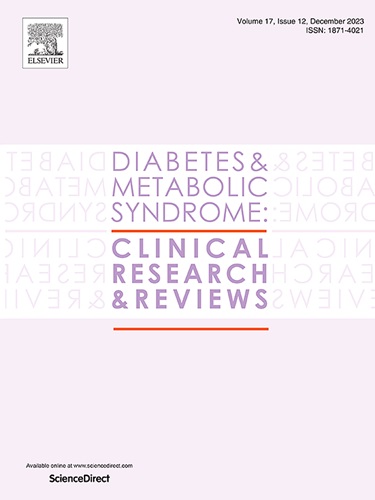前瞻性活检证实糖尿病肾病与非糖尿病肾病的复合肾脏结局:纵向随访
IF 3.4
Q1 ENDOCRINOLOGY & METABOLISM
Diabetes & Metabolic Syndrome-Clinical Research & Reviews
Pub Date : 2025-04-01
DOI:10.1016/j.dsx.2025.103237
引用次数: 0
摘要
目的:本研究旨在评估糖尿病肾病(DKD)和非糖尿病肾病(NDKD)(前瞻性进行,活检证实)复合肾脏结局的差异,以及DKD受试者肾脏结局的预测因素。方法在活检证实的DKD和NDKD患者中记录了包括肌酐加倍、终末期肾病(ESRD)或肾性死亡的复合肾脏结局。比较结果差异(DKD与NDKD)。评估临床、生化和组织病理学参数作为DKD患者复合肾结局的可能预测因素。结果共纳入91例,其中DKD 72例,NDKD 19例。复合肾结局的危险比(HR)为0.27 (0.08-0.9)(p = 0.03),有利于NDKD。Kaplan-Meier分析显示,与DKD患者相比,NDKD患者的综合肾脏预后更好(对数秩卡方为6.69,p = 0.009)。蛋白尿程度和肾脏病理学会(RPS)分级(III/IV)预测DKD患者的预后较差。结论NDKD患者的肾脏综合预后优于DKD患者。组织病理学和蛋白尿程度的RPS III/IV级与DKD患者较差的综合肾脏预后相关。本文章由计算机程序翻译,如有差异,请以英文原文为准。
Composite renal outcome in prospectively performed biopsy proven diabetic kidney disease versus non-diabetic kidney disease: A longitudinal follow up
Aims
This study was undertaken to evaluate differences in composite renal outcomes between diabetic kidney disease (DKD) and non-diabetic kidney disease (NDKD) (prospectively performed, biopsy proven), along with predictors of renal outcome in subjects with DKD.
Methods
A composite renal outcome comprising of doubling of creatinine, end stage renal disease (ESRD) or renal death was documented in biopsy proven DKD and NDKD subjects. Differences in outcome (DKD vs. NDKD) were compared. Clinical, biochemical and histopathological parameters were evaluated as possible predictors of composite renal outcome in DKD.
Results
91 subjects (72 DKD and 19 NDKD) were included for analysis. The hazard ratio (HR) for composite renal outcome was 0.27 (0.08–0.9) (p = 0.03) in favour of NDKD. Kaplan-Meier analysis demonstrated NDKD subjects had better composite renal outcome compared to DKD (log rank chi-square 6.69, p = 0.009). Degree of proteinuria and renal pathology society (RPS) class (III/IV) predicted worse outcome in those with DKD.
Conclusions
Composite renal outcomes in NDKD was better as compared to those with DKD. RPS class III/IV on histopathology and degree of proteinuria was associated with poorer composite renal outcome in patients with DKD.
求助全文
通过发布文献求助,成功后即可免费获取论文全文。
去求助
来源期刊

Diabetes & Metabolic Syndrome-Clinical Research & Reviews
ENDOCRINOLOGY & METABOLISM-
CiteScore
22.90
自引率
2.00%
发文量
248
审稿时长
51 days
期刊介绍:
Diabetes and Metabolic Syndrome: Clinical Research and Reviews is the official journal of DiabetesIndia. It aims to provide a global platform for healthcare professionals, diabetes educators, and other stakeholders to submit their research on diabetes care.
Types of Publications:
Diabetes and Metabolic Syndrome: Clinical Research and Reviews publishes peer-reviewed original articles, reviews, short communications, case reports, letters to the Editor, and expert comments. Reviews and mini-reviews are particularly welcomed for areas within endocrinology undergoing rapid changes.
 求助内容:
求助内容: 应助结果提醒方式:
应助结果提醒方式:


